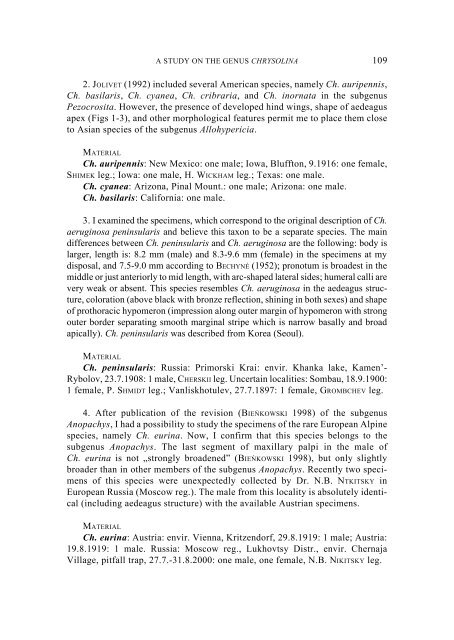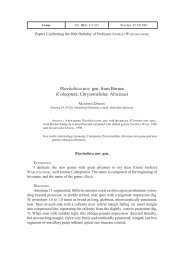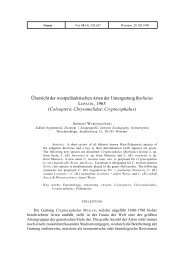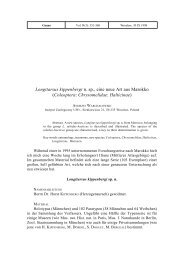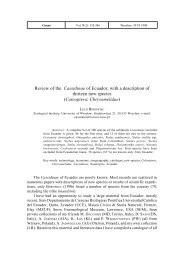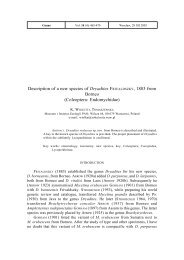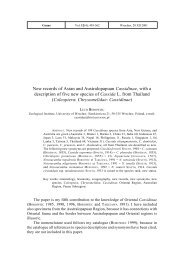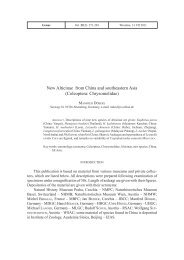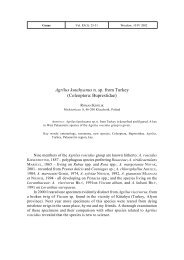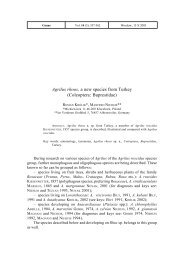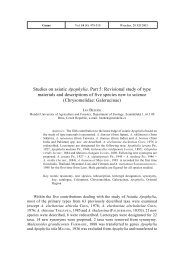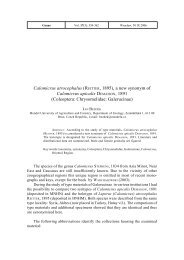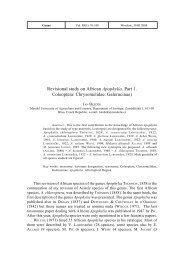A study on the genus Chrysolina MOTSCHULSKY, 1860, with a ...
A study on the genus Chrysolina MOTSCHULSKY, 1860, with a ...
A study on the genus Chrysolina MOTSCHULSKY, 1860, with a ...
Create successful ePaper yourself
Turn your PDF publications into a flip-book with our unique Google optimized e-Paper software.
A STUDY ON THE GENUS CHRYSOLINA<br />
109<br />
2. JOLIVET (1992) included several American species, namely Ch. auripennis,<br />
Ch. basilaris, Ch. cyanea, Ch. cribraria, and Ch. inornata in <strong>the</strong> sub<strong>genus</strong><br />
Pezocrosita. However, <strong>the</strong> presence of developed hind wings, shape of aedeagus<br />
apex (Figs 1-3), and o<strong>the</strong>r morphological features permit me to place <strong>the</strong>m close<br />
to Asian species of <strong>the</strong> sub<strong>genus</strong> Allohypericia.<br />
MATERIAL<br />
Ch. auripennis: New Mexico: <strong>on</strong>e male; Iowa, Blufft<strong>on</strong>, 9.1916: <strong>on</strong>e female,<br />
SHIMEK leg.; Iowa: <strong>on</strong>e male, H. WICKHAM leg.; Texas: <strong>on</strong>e male.<br />
Ch. cyanea: Ariz<strong>on</strong>a, Pinal Mount.: <strong>on</strong>e male; Ariz<strong>on</strong>a: <strong>on</strong>e male.<br />
Ch. basilaris: California: <strong>on</strong>e male.<br />
3. I examined <strong>the</strong> specimens, which corresp<strong>on</strong>d to <strong>the</strong> original descripti<strong>on</strong> of Ch.<br />
aeruginosa peninsularis and believe this tax<strong>on</strong> to be a separate species. The main<br />
differences between Ch. peninsularis and Ch. aeruginosa are <strong>the</strong> following: body is<br />
larger, length is: 8.2 mm (male) and 8.3-9.6 mm (female) in <strong>the</strong> specimens at my<br />
disposal, and 7.5-9.0 mm according to BECHYNÉ (1952); pr<strong>on</strong>otum is broadest in <strong>the</strong><br />
middle or just anteriorly to mid length, <strong>with</strong> arc-shaped lateral sides; humeral calli are<br />
very weak or absent. This species resembles Ch. aeruginosa in <strong>the</strong> aedeagus structure,<br />
colorati<strong>on</strong> (above black <strong>with</strong> br<strong>on</strong>ze reflecti<strong>on</strong>, shining in both sexes) and shape<br />
of prothoracic hypomer<strong>on</strong> (impressi<strong>on</strong> al<strong>on</strong>g outer margin of hypomer<strong>on</strong> <strong>with</strong> str<strong>on</strong>g<br />
outer border separating smooth marginal stripe which is narrow basally and broad<br />
apically). Ch. peninsularis was described from Korea (Seoul).<br />
MATERIAL<br />
Ch. peninsularis: Russia: Primorski Krai: envir. Khanka lake, Kamen’-<br />
Rybolov, 23.7.1908: 1 male, CHERSKII leg. Uncertain localities: Sombau, 18.9.1900:<br />
1 female, P. SHMIDT leg.; Vanliskhotulev, 27.7.1897: 1 female, GROMBCHEV leg.<br />
4. After publicati<strong>on</strong> of <strong>the</strong> revisi<strong>on</strong> (BIEÑKOWSKI 1998) of <strong>the</strong> sub<strong>genus</strong><br />
Anopachys, I had a possibility to <str<strong>on</strong>g>study</str<strong>on</strong>g> <strong>the</strong> specimens of <strong>the</strong> rare European Alpine<br />
species, namely Ch. eurina. Now, I c<strong>on</strong>firm that this species bel<strong>on</strong>gs to <strong>the</strong><br />
sub<strong>genus</strong> Anopachys. The last segment of maxillary palpi in <strong>the</strong> male of<br />
Ch. eurina is not „str<strong>on</strong>gly broadened” (BIEÑKOWSKI 1998), but <strong>on</strong>ly slightly<br />
broader than in o<strong>the</strong>r members of <strong>the</strong> sub<strong>genus</strong> Anopachys. Recently two specimens<br />
of this species were unexpectedly collected by Dr. N.B. NTKITSKY in<br />
European Russia (Moscow reg.). The male from this locality is absolutely identical<br />
(including aedeagus structure) <strong>with</strong> <strong>the</strong> available Austrian specimens.<br />
MATERIAL<br />
Ch. eurina: Austria: envir. Vienna, Kritzendorf, 29.8.1919: 1 male; Austria:<br />
19.8.1919: 1 male. Russia: Moscow reg., Lukhovtsy Distr., envir. Chernaja<br />
Village, pitfall trap, 27.7.-31.8.2000: <strong>on</strong>e male, <strong>on</strong>e female, N.B. NIKITSKY leg.


